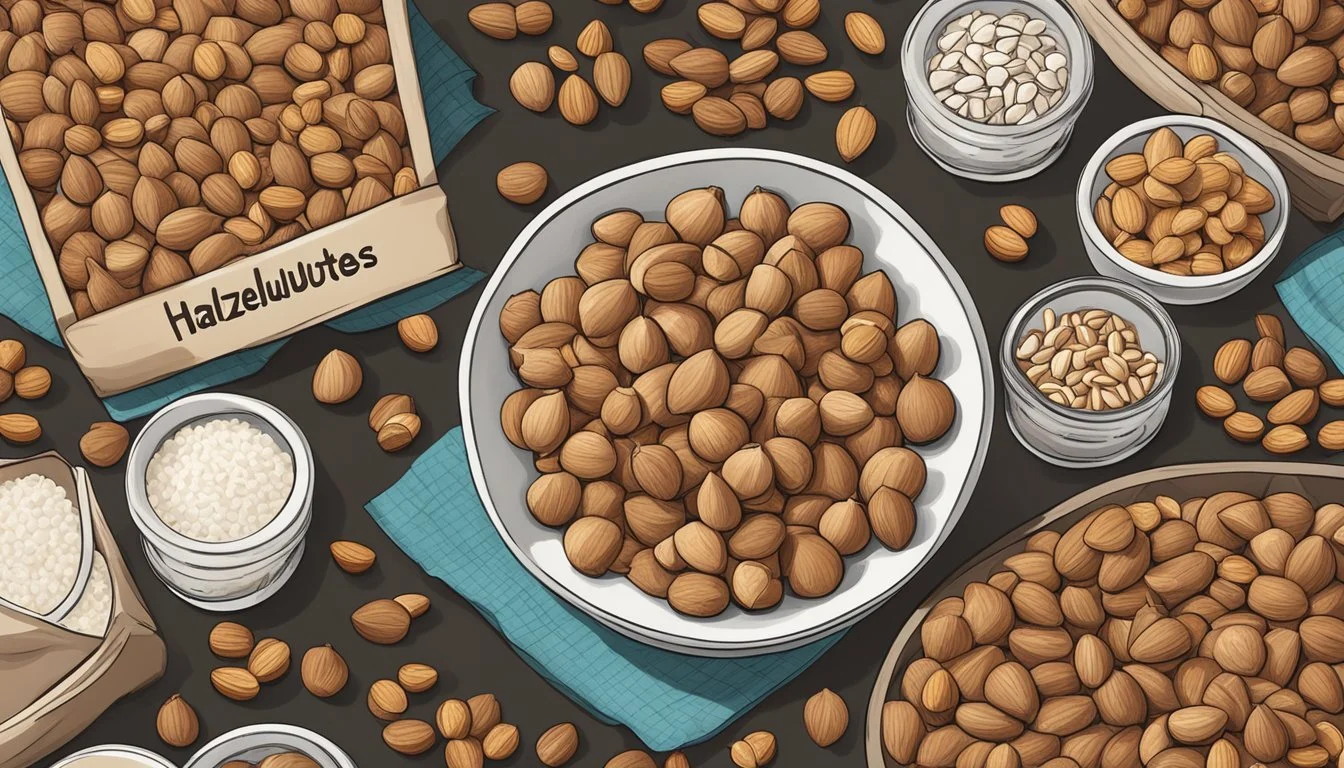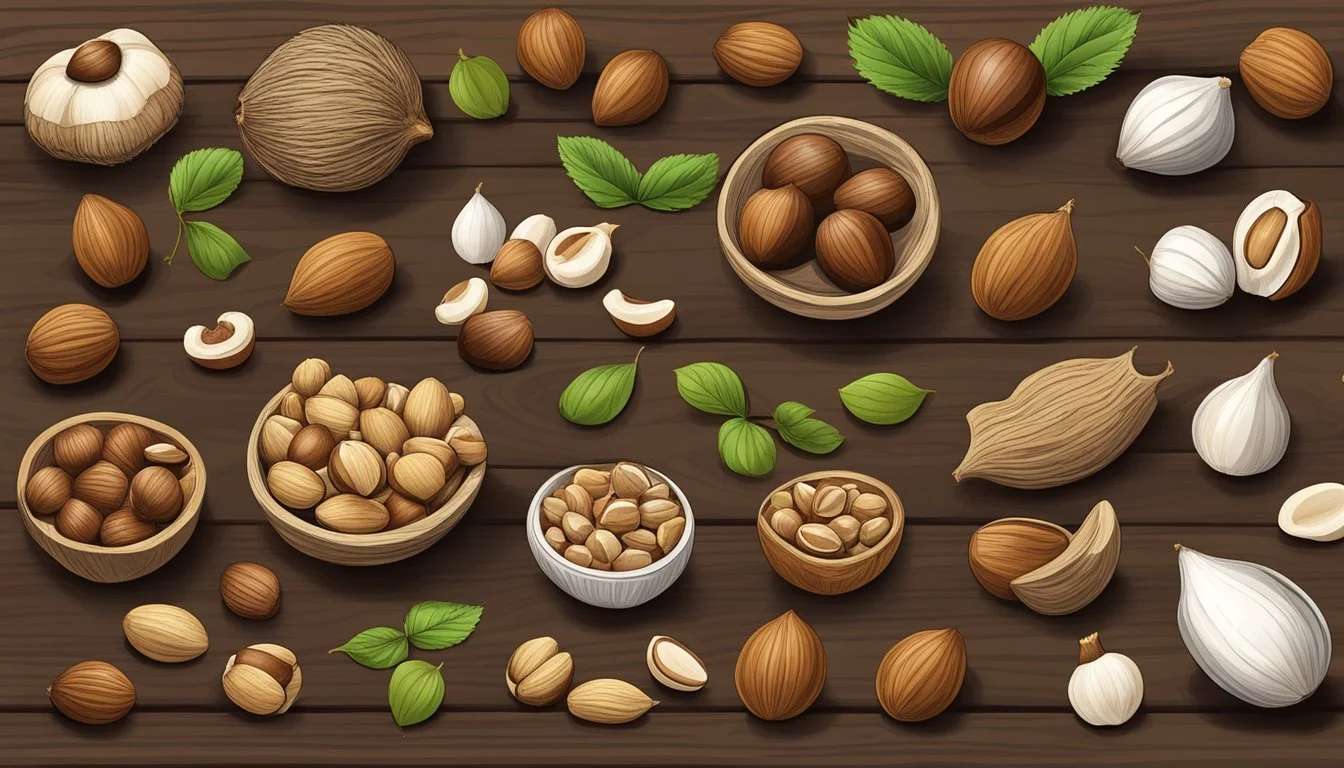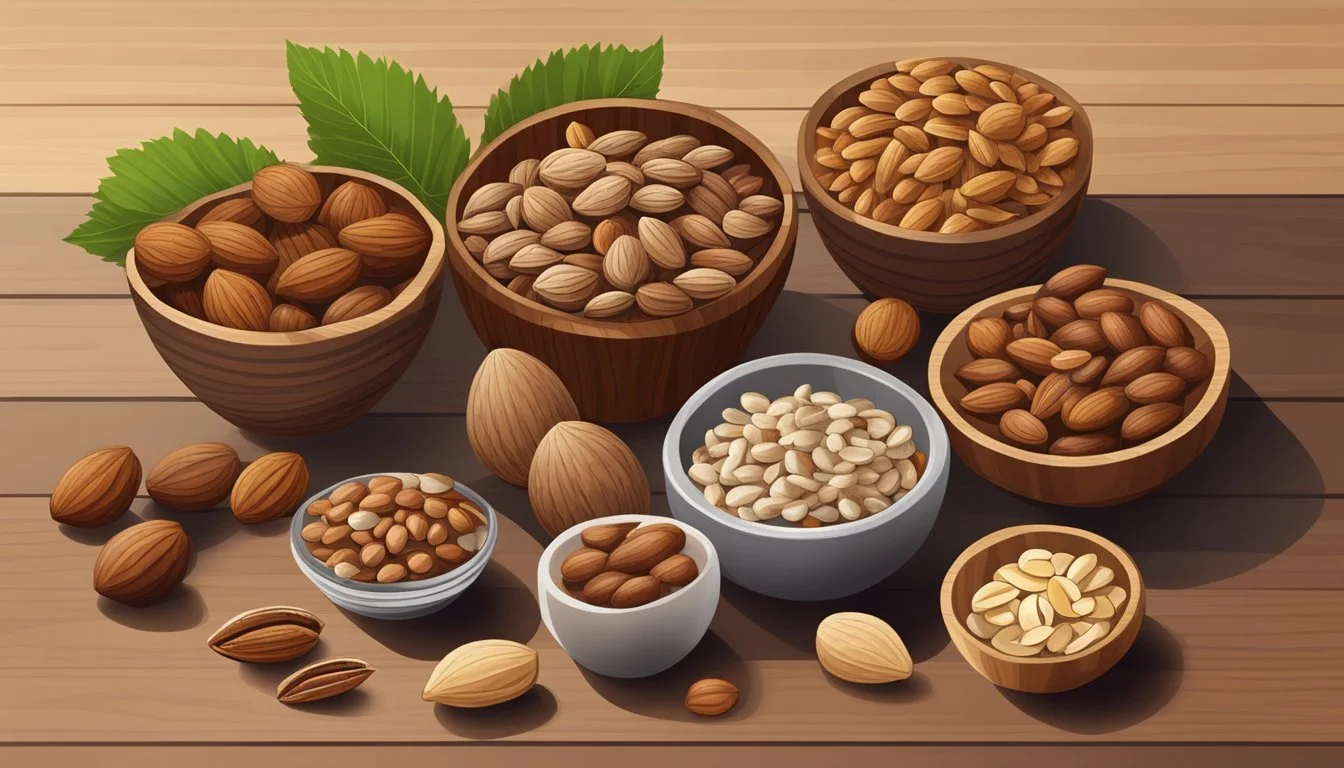Hazelnut (Filbert) Substitutes
Top Alternatives for Baking and Cooking
When a recipe calls for hazelnuts, also known as filberts, and they’re not available or suitable for the consumer's dietary needs, finding the right substitute is essential for both flavor and texture in culinary ventures. Hazelnuts are valued for their sweet, nutty taste and are used in a variety of dishes, from baked goods to savory spreads. However, there are various reasons one might seek an alternative, ranging from allergies to local availability. Fortunately, several other nuts and ingredients can successfully mimic the characteristics of hazelnuts in recipes, ensuring that the end result retains its intended deliciousness.
Chestnuts are a commendable alternative, providing a mildly sweet and earthy flavor that complements dishes commonly made with hazelnuts. Their softer texture, once cooked, can make them a suitable replacement in purees, soups, or even stuffing. Other nuts like macadamia, almonds, and pecans offer similar textures and tastes, with almonds being a particularly popular substitution due to their widespread availability and familiar flavor profile. Each of these substitutes brings its own unique qualities to a dish, while still delivering the nuttiness required.
A clever twist for hazelnut substitutes can be found in hazelnut-derived products such as Nutella or hazelnut extract. These can impart the specific essence of hazelnuts to desserts and baked goods, without the need for the whole nut. The method of substitution, whether it’s a one-to-one ratio or a varied measurement, along with preparation techniques like roasting or boiling, will affect both the dish’s texture and flavor depth. It's crucial to consider these factors when selecting a substitute for hazelnuts to ensure the integrity of the dish remains intact.
Understanding Hazelnuts
Hazelnuts are a nutritious ingredient recognized for their rich taste and versatility in cooking and baking. They play an essential role in culinary applications and offer significant health benefits.
Nutritional Benefits of Hazelnuts
Hazelnuts are an excellent source of healthy fats, notably monounsaturated fats, which can help maintain healthy cholesterol levels and promote heart health. They are also rich in protein, fiber, and essential minerals such as magnesium, zinc, iron, and potassium. The high content of vitamin E in hazelnuts contributes to their nutritional value and is known for its antioxidant properties.
Healthy Fats: Predominantly monounsaturated
Protein: Essential for tissue repair and growth
Fiber: Aids in digestive health
Vitamin E: Acts as an antioxidant
Minerals: Magnesium, Zinc, Iron, Potassium
Common Uses in Cooking and Baking
Hazelnuts are widely used in cooking and baking due to their versatile nature. They can be chopped, ground, or used whole in various recipes. Hazelnuts enrich baked goods like cakes, cookies, and pastries with a distinct, nutty flavor and texture. They are also incorporated into confectionery items, spreads such as hazelnut butter, and used as a garnish or ingredient in savory dishes.
Baked Goods: Cakes, cookies, pastries
Confectionery: Chocolates, pralines
Spreads: Hazelnut butter, chocolate-hazelnut spreads
Savory Dishes: Garnishes, ingredient in sauces
Distinct Hazelnut Flavor Profile
The flavor of hazelnuts is uniquely sweet and nutty, making it a favored element in both sweet and savory recipes. The taste of hazelnuts is amplified when they are toasted, allowing their rich, bold flavor to stand out even more. This characteristic taste is a cornerstone of many iconic dishes and products, playing a critical role in their overall flavor profiles.
Hazelnut Substitutes for Various Needs
When a recipe calls for hazelnuts, various alternatives can cater to different dietary needs or preferences. This section explores nut replacements, seed-based options, and nut-free solutions.
Top Nut Alternatives
The best nut substitutes for hazelnuts maintain a similar texture and flavor profile. Here's a list of top choices:
Almonds: Their firm crunch and subtle sweetness make them a suitable substitute. They can be used in a 1:1 ratio.
Pecans: Pecans provide a buttery and slightly sweet taste, ideal for baked goods, and are interchangeable in equal amounts.
Walnuts: Walnuts offer a robust, earthy flavor that complements recipes where nuts are a highlight. Use them in the same quantity as hazelnuts.
Cashews: With their smooth texture and mild taste, cashews are versatile and work well when ground into pastes or butter.
Macadamia Nuts: While richer, macadamias can substitute hazelnuts, especially in confectionery items, used in equal measure.
Pistachios: These nuts bring a unique color and a distinct, slightly sweet flavor, ideal for both sweet and savory dishes.
Seed-Based Substitutes
Seeds can be excellent alternatives for those looking for varied textures and flavors or for those with nut allergies. Prominent seed substitutes include:
Sunflower Seeds: Offering a nut-like flavor with a mild, earthy undertone, they can be used in place of hazelnuts, especially in baked recipes.
Pumpkin Seeds: Their rich, savory taste makes them a good choice for savory dishes, though they can also find use in sweets.
Nut-Free Options for Allergies
For individuals with nut allergies, finding a safe and flavorful replacement is crucial. Here are some nut-free choices:
Roasted Chickpeas: These can provide a nutty flavor and crunch.
Pretzels: When crushed, they offer a crunchy texture suitable for topping dishes.
Soy Nuts: These roasted soybeans have a crunchy texture and are great in trail mixes or as a snack on their own.
Nut-free grains and cereals, if processed in a safe environment, are also viable options to achieve the desired texture without the risk of allergic reactions.
Specialty Hazelnut Products and Alternatives
When searching for alternatives to specialty hazelnut products, it is essential to consider both flavor and texture. This section explores non-nut-based flavorings that mimic hazelnut and suitable replacements for hazelnut oil and extract.
Non-Nut-Based Hazelnut Flavorings
For those who wish to achieve the distinctive taste of hazelnuts without using the nuts themselves, various non-nut-based options are available.
Artificial Hazelnut Flavoring: A common ingredient found in syrups or in baking, artificial hazelnut flavoring can be used to mimic the nut's essence in recipes.
Natural Hazelnut Flavor (Non-Nut Source): Derived from natural substances, these flavorings offer a hazelnut profile suitable for individuals with nut allergies.
Hazelnut Oil and Extract Replacements
Replacement options for hazelnut oil and extract maintain a seamless transition in recipes, focusing on preserving the intended flavor and richness.
Hazelnut Oil Alternatives:
Sunflower Oil: Neutral and light, suitable for dressings and cooking.
Almond Oil: If allergies are not a concern, offers a comparable nuttiness.
Hazelnut Extract Substitutes:
Vanilla Extract: Provides a sweet and aromatic profile.
Almond Extract: Another nut-based extract, rich in flavor, but only when allergies are not an issue.
In culinary applications where the texture is also essential, such as in baked goods or spreads, finding an alternative that offers both the characteristic flavor and consistency of products like hazelnut flour, hazelnut butter, or hazelnut chocolate spread (e.g., Nutella) can be more challenging. In these cases:
Hazelnut Flour Alternative:
Acorn Flour: Offers a nutty, rich flavor and is gluten-free.
Hazelnut Butter and Hazelnut Chocolate Spread Alternatives:
Sunflower Seed Butter: Matches the creaminess with a nutty taste.
For Nutella Alternatives:
Consider store-bought chocolate spreads without hazelnuts.
Cocoa powder mixed with almond butter delivers a complementary richness and taste.
Finally, for hazelnut liqueur, the substitute would depend on whether the role in the recipe is primarily flavor or alcohol content. If it's the former, a combination of non-alcoholic hazelnut syrup with a base liquor could suffice. Where chocolate is a paired flavor, the combination of cocoa and the substitute of choice may achieve the desired profile, especially in desserts and drinks.
Substitution Considerations
When selecting a substitute for hazelnuts, it's crucial to consider how it will affect the final dish in terms of texture, nutritional content, flavor harmony, and practical aspects like availability and cost.
Impact on Texture and Consistency
A substitute's texture can markedly change a dish. For instance, when replacing hazelnuts in muffins or cookies, a substitute with a crunchy texture is desirable. Pecans and almonds offer a solid crunch and can maintain the satisfying chew expected in these baked goods. Granola can be an alternative, providing a distinct texture and consistency in desserts and salads.
Crunchy texture: Pecans, almonds, granola
Suitable for muffins, cookies, cakes, and pies
Maintaining Nutritional Content
Hazelnuts are rich in nutritional benefits, including healthy fats, fiber, and protein. Substitutes should ideally possess similar nutritional profiles to uphold the health attributes of the dish. Nuts like almonds are nutritionally dense and, being a direct nut replacement, align well with maintaining the nutritional content of recipes.
Nutritional benefits: Almonds (healthy fats, fiber, protein)
Application: Salads, granola bars, health-conscious desserts
Flavor Pairings and Complementary Ingredients
The unique, sweet, and nutty flavor of hazelnuts is a key component in many dishes. Substitutes should harmonize with other ingredients without overpowering them. For slightly sweet nutty flavors, chestnuts can be used in savory applications like stuffings and soups, whereas almonds complement both sweet and savory dishes. The choice of substitute may vary based on whether the dish is a savory pie or a sweet cake.
Slightly sweet and nutty flavors: Chestnuts (stuffing, soups), Almonds (desserts, pastries)
Consider complementing ingredients in the recipe
Availability and Cost Factors
Accessibility and expense are practical concerns. The prevalence and price of hazelnuts vary by location and season. Alternatives like acorn flour or pecans may provide a cost-effective solution or a more readily available option in certain regions. It's advisable to assess the local market to determine the most accessible and budget-friendly choice.
Cost-effective options: Acorn flour, pecans
Investigate local availability for the best substitute choice
By thoughtfully considering these factors, one can choose a suitable hazelnut substitute to achieve a comparable result in both taste and texture, while also taking into account health benefits, cost, and availability.
Alternative Applications in Recipes
When substituting hazelnuts in recipes, one can maintain the integrity of the dish by carefully selecting alternatives that offer similar flavors and textures. These substitutions can be applied across a spectrum of dishes, from sweet baked goods to savory plates.
Baked Goods and Desserts
Substituting nuts in baked goods and desserts requires alternatives that can withstand the baking process without losing their integrity.
Macadamia nuts: They are an ideal substitute in cookies and cakes due to their rich, buttery flavor. When replacing hazelnuts, use an equal measure of macadamia nuts.
Almonds: Their crunch and chewiness make them a great replacement in items like sweet chips and praline. Again, use a one-to-one ratio for substitution.
For pies and pie crusts, one can opt for pecans to maintain a comparable texture and taste. In bread recipes, granola can contribute a similar crunchiness and enhance the overall flavor profile.
Health-Conscious Snacking
For those focused on health-conscious snacking, certain substitutes not only mimic the taste and texture of hazelnuts but also offer nutritional benefits.
Granola: It serves as a nutritious substitute in muffins or granola bars, often packed with fiber, proteins, and healthy fats.
Almonds and Macadamia nuts: These nuts are suitable for snacking as they possess similar textures to hazelnuts and are rich in healthy fats and proteins.
Savory Dishes
Hazelnuts are not just limited to sweet dishes; they are also a component in savory dishes, used as toppings or integrated into the recipe for an added dimension of flavor and texture.
Brazil nuts: Their similar size and texture make them a suitable alternative for savory applications such as salads.
Almonds: They can be used as a crunchy component in salads or as a crust for proteins, enhancing the dish without overpowering other ingredients.
When selecting substitutes in any savory dish, it's important to balance the nut's inherent flavors with the overall taste profile of the recipe to achieve the desired outcome.
Health and Dietary Consideration
When considering substitutes for hazelnuts, it is important to address specific health and dietary aspects such as dealing with allergies, enhancing heart and skin health, as well as managing weight and blood sugar levels.
Managing Food Allergies
For individuals with nut allergies, finding a nut-free substitute for hazelnuts is crucial. Seeds such as sunflower or pumpkin seeds can be a safe alternative, providing a similar crunch with none of the allergenic proteins found in nuts. Additionally, for those allergic to tree nuts but not legumes, options like soy nuts or peanut butter could be considered; however, always check with a healthcare provider before introducing new foods into an allergy-sensitive diet.
Promoting Heart and Skin Health
Substitutes rich in healthy fats, such as almonds or macadamia nuts, contribute to good cholesterol levels and can support heart health. These nuts are also high in vitamin E, which benefits skin health due to its antioxidant properties. To replace hazelnuts, use:
Almonds: Similar in texture and flavor, excellent for heart and skin health.
Macadamia nuts: A rich, buttery alternative that also promotes healthy skin.
Weight Management and Blood Sugar Levels
Nuts and their substitutes are typically high in fiber and protein, which can aid in weight management by promoting a feeling of fullness. For those monitoring their blood sugar levels, lower glycemic index options such as almonds or walnuts can replace hazelnuts without causing significant blood sugar spikes. Nuts also contain healthy fats which, in moderation, can form part of a balanced diet that supports weight management goals.
Substitutes Around the World
Hazelnut substitutes can vary greatly by geography, with local nuts and seeds taking the spotlight in regional culinary practices.
Cultural Variations of Hazelnut Substitutes
In Turkey, where hazelnuts are highly prevalent, finding a substitute may be a nod to creativity rather than necessity. Yet, when one is needed, almonds often serve this role, preserving the distinctive texture and sweetness in traditional Turkish dishes.
USA offers a diverse palette of alternatives. Pecans, with their rich flavor and crunchy texture, are commonly used across the country as a close substitute in baked goods and confections. Macadamia nuts find favor in more gourmet treats, lending a buttery taste that is especially popular in the state of Hawaii.
Local Nut and Seed Options
In Brazil, the robust brazil nut stands in for hazelnuts, bringing a creamy texture to desserts and snacks. The nut is native to the Amazon and is frequently used in its whole form or as an oil.
Across Europe, chestnuts offer a milder, sweeter option akin to hazelnuts. In Italy, for instance, chestnut flour is an integral ingredient for various regional specialties.
Moving over to the drier characteristics, peanuts and cashew nuts offer versatility and are widely accessible around the world. While not as rich, these nuts can mimic the utility of hazelnuts in various recipes when roasted to enhance their flavor profile.
Filberts and cobnuts, terms often used in some regions for hazelnuts, are particularly embraced in the UK, where they have historic culinary significance and are among the preferred local options.
Finally, adaptability drives the inclusion of other nuts in recipes where hazelnuts are traditional. Factors such as availability, flavor profile, and texture determine the best local substitute, facilitating seamless culinary substitutions around the globe.
Conclusion
When seeking substitutes for hazelnuts in cooking and baking, several options are available that can offer similar taste, texture, and nutritional content. For those who are looking for an alternative due to allergies, personal preference, or availability, the following options can serve as suitable replacements:
Almonds: They have a comparable texture and are rich in nutrients, making them excellent for both baking and cooking.
Walnuts: Their robust flavor can complement various recipes, though they have a slightly more bitter taste.
Pecans: Milder and sweeter, these nuts are a good match for desserts and are also nutritious.
Each substitute brings its own unique qualities to dishes while providing various vitamins, minerals, and healthy fats akin to those found in hazelnuts.
Substitute Flavor Profile Best Used In Almonds Mild, sweet Baking, garnishes, pesto Walnuts Rich, earthy Breads, cookies, salads Pecans Sweet, buttery Desserts, pie crusts, confections
It is important for individuals to be mindful of their specific dietary needs while substituting. If one is replacing hazelnuts due to an allergy to tree nuts, these alternatives should be avoided and seeds or legumes could be considered instead.
In conclusion, there are multiple substitutes for hazelnuts that can be employed in various culinary applications. Whether the goal is to imitate the flavor or maintain the nutritional integrity of the dish, the options available ensure that any recipe can be successfully adapted to suit individual needs without compromising on taste or health benefits.









